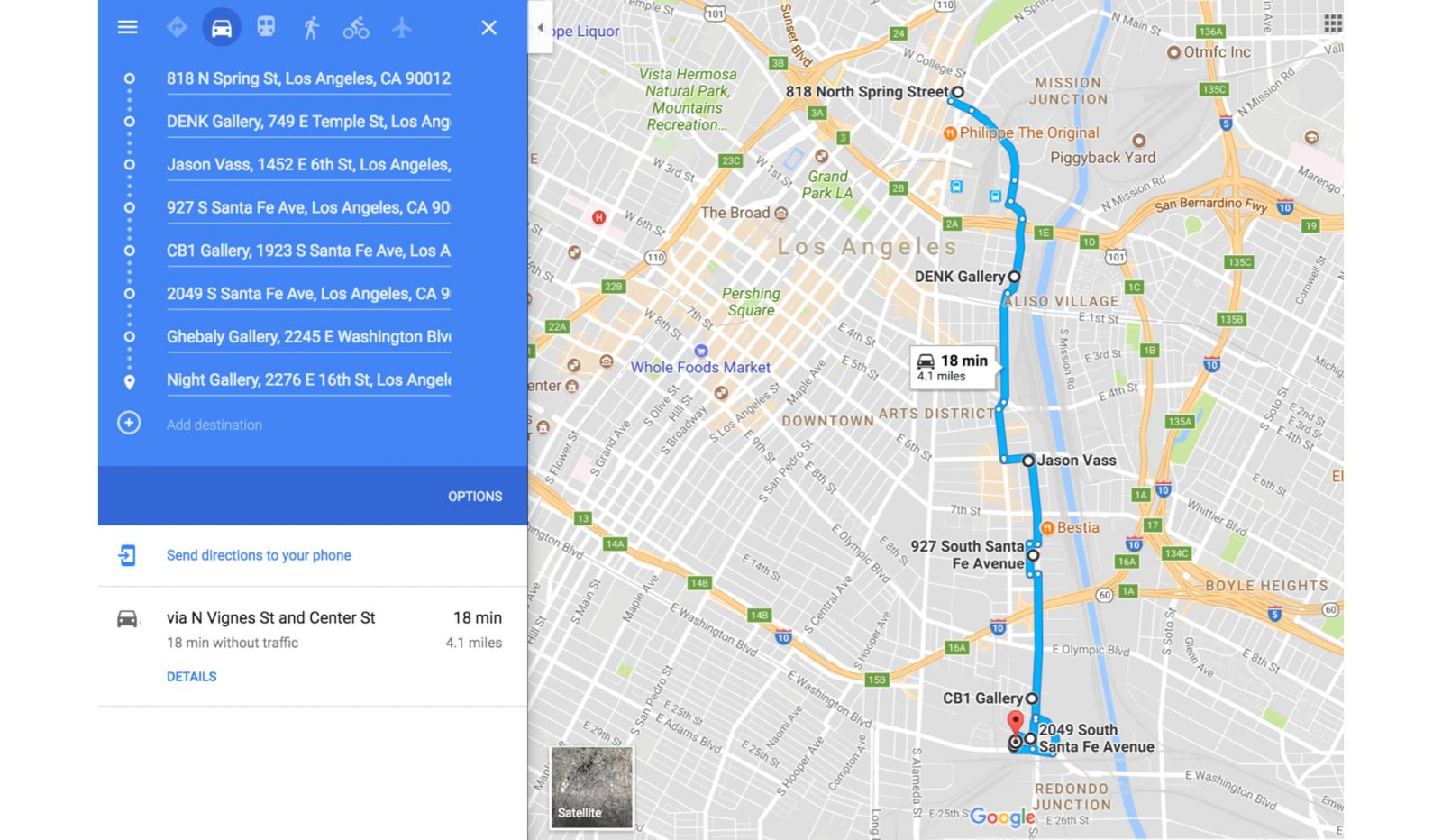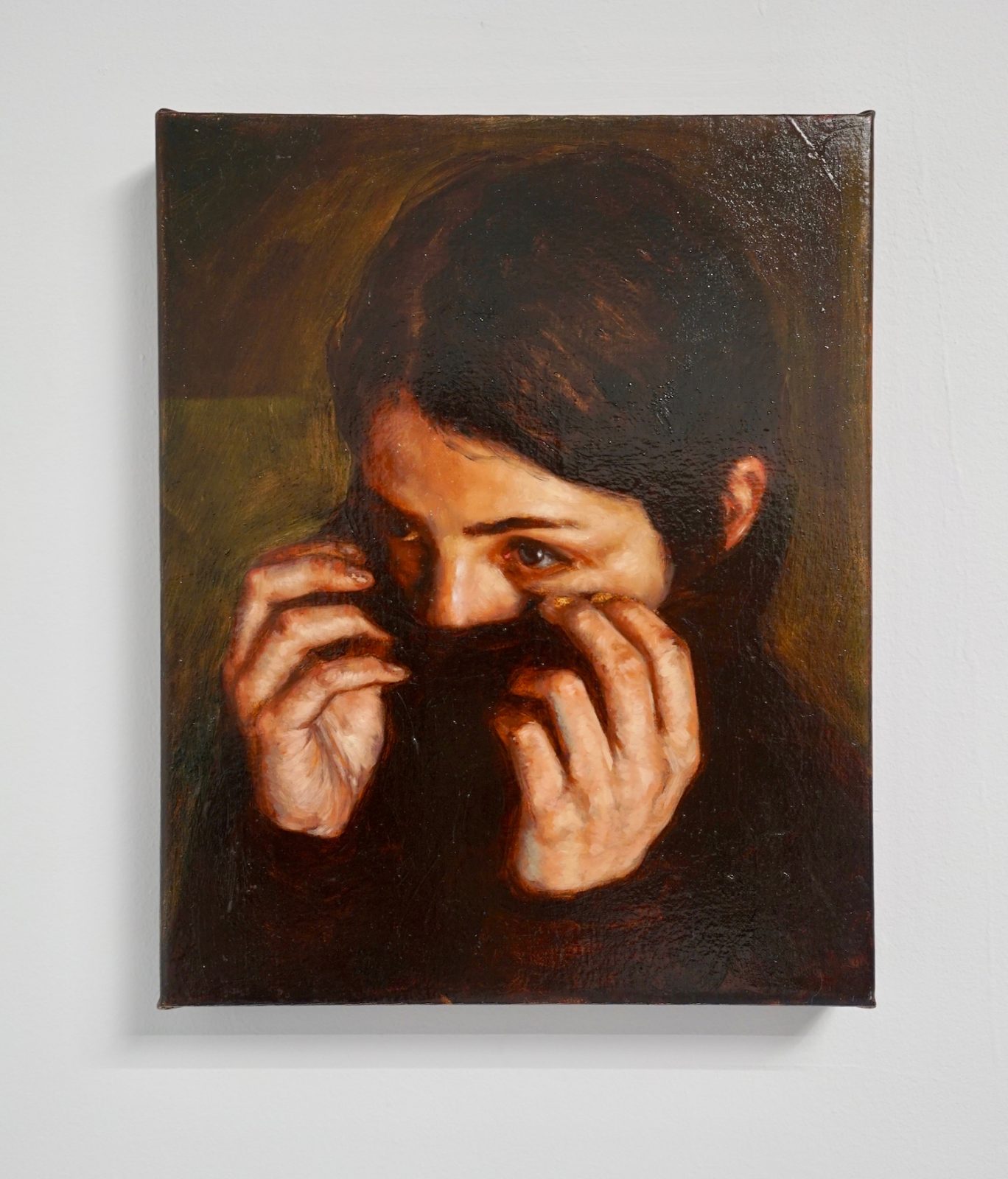LA-based artist, Andrea Nakhla takes us on a truly epic art crawl in LA’s Chinatown and downtown Arts District. Hitting up 7 shows in one night, she walks us through LA’s vibrant art scene and shares some of the highlights of the night. If you’re feeling ambitious, you can plan out your own art crawl too. Andrea shows you how, below.

As someone who is always DMing art opening invites to my friends with good intentions that we both know will never follow through, this past Saturday I finally made an itinerary for us with the goal of seeing 8 shows in one night. We made it to 7/8. CB1 closed too early, but if you want to steal my route and go during a weekday you can catch them all. We just went to openings but there are also lots of other great shows currently happening in the same area, the ArtForum App and Curate.La are great resources for making your own map of maximum art, minimum driving.
1. Zero Zero Gallery, “Notion of a Threshold”, Duda Bebek and Malin Gabriella
We started off at 0-0 gallery in Chinatown. A new gallery, that since opening in February has had a really solid line-up of shows.
Notion of a Threshold is a dual showcase of Swedish painters Duda Bebek and Malin Gabriella Nordin. The exhibition combines the work of two artists with particularly emotive styles for a deftly visceral art experience.

Malin Gabriella Nordin is often associated with the colorful, expressive, and organic compositions she creates and presents in the form of paintings, drawings, or sculpture. She favors a playfully spontaneous aesthetic that ranges from almost childlike in it’s freedom, to complex and highly detailed. Nature is undeniably present in Nordin’s art.

Duda Bebek is interested in the symbols society creates through ascribed norms and values, the female body being of particular interest because of it’s inescapably connotative status. By incorporating and exaggerating easily identifiable themes and symbols concerning beauty, sexuality, and pop culture she challenges the preconceived ideas and feelings we harbor against them. The viewer becomes the decipherer of symbols that no longer offer any direct subtext or reference.

2. DENK, “Conceptual Craft”, Lynn Aldrich, Jeff Colson, Ashley Hagen, Tim Hawkinson, Nova Jiang, Jared Pankin, Ephraim Puusemp, and Pontus Willfors
Conceptual Craft, a group exhibition featuring work by artists, who although are all producing different types of sculptural work in unique ways, are united by a similar preoccupation with labor intensive, studio-based practices, and an inventive use of materials.

Pontus Willfors, Rocking Chair 2017

Lynn Aldrick, Sprinkler, 2017
Lynn Aldrich works with found household and hardware materials such as sponges, hoses, gutters, and tubing, to create abstract sculptural works that feel like marine creatures at times and architectonic structures at others. Her compositions, though assembled from these unassuming parts, are expertly transformed into dynamic investigations of our culturally inculcated mass consumption and its deleterious environmental consequences.

Tim Hawkinson, Gumball, 2017
Tim Hawkinson, also using found and common everyday materials, creates biomorphic objects, at times kinetic, that explore themes like the body, transformation, the organic interacting with the mechanical, and the associations of the subconscious. His elaborate constructs, always driven by a conceptual and idea-based approach to materials, harness the transformative potential of physical reinvention.
Also shoutout for best food and drinks of the evening.

3. Jason Vass, “Artempatia”, Emiliano Gironella Parra
For Emiliano Gironella Parra, art is a powerful tool to modify paradigms and preconceived stories; a tool that is key in changing the vision held abroad about Mexico and inspiring radical change and education within the country. Artempatía, or “Empathy Art”, is the stimulation of our natural empathy through teaching and practicing art, as well as a set of collaborative artistic actions seeking the identification and recognition of the victims of violence and their loved ones. Gironella Parra’s work specifically addresses the violence in Mexico in connection to drug trafficking within the country, and is an attempt for reconciliation between society and police.



4. Werkartz, “The Panacea Project”, Bettina Hubby, Adrienne Adar, Michael G Bauer, Nancy Barber, Carl Berg, Agnes Bolt, Cal Clements, Michael Dee, Bob Dornberger, Amanda Yates Garcia, Emma Gray, Alex Miller, Jeremy Shockley, Joe Sola, William Stone and Nicola Vruwink.


“This show is a conscious choice, a treasure hunt for some bliss, a bit of calm, a jolt of laughter, an ooooh, an ahhhhh, or a nervous chuckle at the way things are. It’s an admission that our world is full of strife and contrast and whilst aware, to throw out this open-armed hug – a palliative gesture. There is a great power in collective pursuits of Cheer.
Therefore there are plenty of hugs in this show, and unpredictable rainbows. There are ebullient Guston-ian ballooning ceramics whilst others erupt with fantastical solidity and more with happy glazes and twisted smiles. There are drawings with a hurricane of mantras, collages of cosmic reminders of space and time, a humorous painting with literal heart, as well as heat-beating poetic furniture and paintings that bathe you with light and streaker freedom. You’ll be virtually surrounded by ridiculously beautiful animals getting along with each other despite their differences, and confronted with the undeniable beauty of the natural world. There is work here that will attempt to dunk you in the sublime, surround you with cozy comforts, and fully immersive reminders that our companion flora are alive and humming,I chose to douse you with humor, both direct and sly, beauty, animals and a barrage of positivity to overwhelm your senses, soothe, repair and amuse you…or at the very least allow you to escape for a while.”
-Betina Hubby, show curator + artist


5. MAMA, “Mad Demons”, Scott Laufer
We made it to MAMA just in time to catch Scott Laufers debut exhibition “Mad Demons”. MAMA gallery has moved out of it’s original warehouse space and this show is up in a temporary spot on Santa Fe. MAMA is another gallery that has always had a really solid line up of shows and IMO usually the best dressed crowd, just FYI – if you are single – maybe check out some openings here?
Laufer examines the subject of inner conflict which follows the reconciliation of an upbringing in rural America and the perspective gained from leaving it behind. The works presented employ a classical methodology, resulting in an exploration that rises with frustration and conflicting notions of simultaneous bondage and freedom. Laufer’s unremitting cross-examination of truth and disillusionment culminates in a melancholic series of paintings that attempt to pose the provocative question, “Am I still who I was?”.



Untitled (the feeling of emasculation that occurs when you meet your girlfriends girlfriend), 23 x 28 cm oil on canvas, 2016

Young Shame, 28 x 36 cm oil on canvas, 2015
We got there 5 minutes before the show closed, but also right when some pizza showed up so it all worked out.

6. Ghebaly Gallery, “Upstream”, Basel Abbas and Ruanne Abou-Rahme, Marius Bercea, Marcello Dolce, Patrick Jackson, Marina Pinksy, Laure Prouvost, and Louise Sartor
The artists in Upstream assess radical disruptions of stasis, proposing adaptations and new ways forward: new myths for new histories, new skills for new labor, new erotics for new bodies. My favorite works were the rebar stick figures with flatscreen television heads by Laure Prouvost. The figures mop the floor and gaze at the art while their thoughts – a stream of pronouncements, images, and sounds – emanate from their faces. These works, with their humorous and casually poetic use of language, emblematize Prouvost’s larger consideration of labor, fantasy, and pleasure.



7. Night Gallery, “Menace II Society”, Awol Erizku
We ended at Night Gallery, to catch Awol Erizku’s show Menance II Society, I’ve been a fan of his for a while so I was pretty excited to see it IRL. It did not disappoint.
The exhibition collapses America’s history of institutionalized racism, and it’s counter strategies, from the late 1960’s into the future to better understand our political moment. Erizku’s paintings are heavily sculptural using corrugated metal, plastic sheets, plywood, and pallets to denounce Euro-centric painting standards of working on smooth white gessoed canvases.

Erizku displays a new series of work on assembled plywood and pallets that are screen-printed and colorfully “painted in”. The images are pulled from the storied “Black Panther Coloring Book”. The coloring book was submitted to the black Panthers by an aspiring recruit in 1968, but was found to be inappropriate to represent the party and not suitable for publication. Later 1,000 unauthorized copies were printed by an FBI informer and party defector and distributed in white suburbs tarnishing the image of black America and violating the civil rights of the Black Panther Party.




Comments